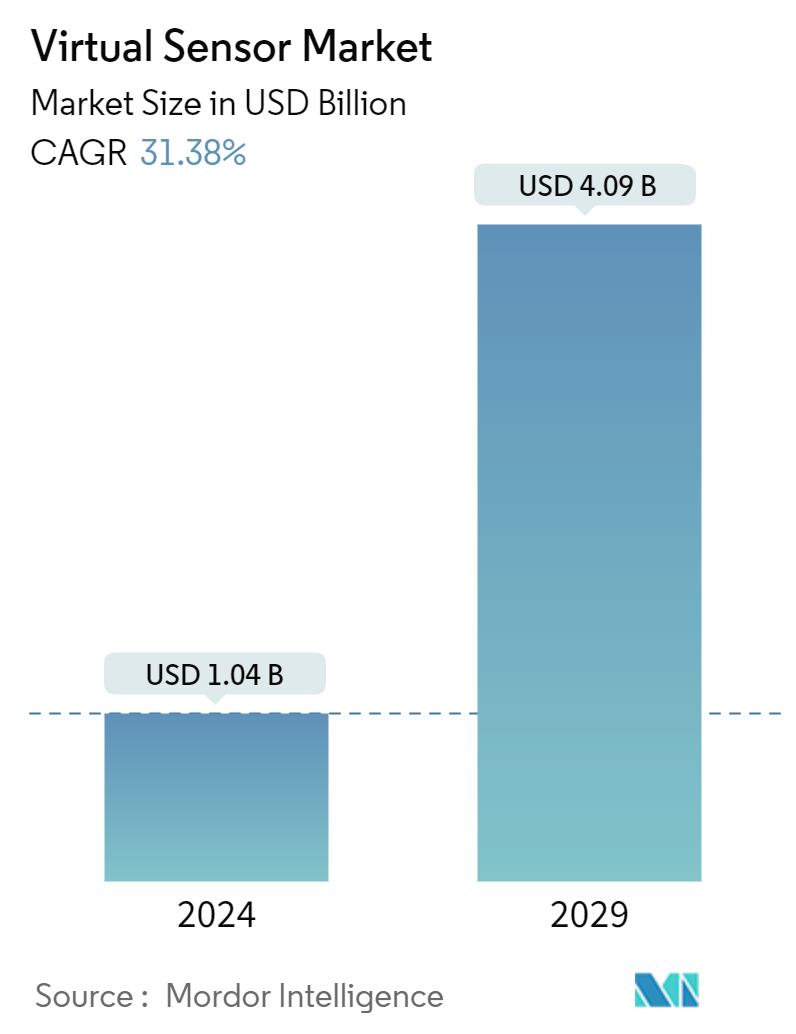Market Size of Virtual Sensor Industry

| Study Period | 2019 - 2029 |
| Market Size (2024) | USD 1.04 Billion |
| Market Size (2029) | USD 4.09 Billion |
| CAGR (2024 - 2029) | 31.38 % |
| Fastest Growing Market | Asia Pacific |
| Largest Market | Asia Pacific |
Major Players
*Disclaimer: Major Players sorted in no particular order |
Need a report that reflects how COVID-19 has impacted this market and its growth?
Virtual Sensors Market Analysis
The Virtual Sensor Market size is estimated at USD 1.04 billion in 2024, and is expected to reach USD 4.09 billion by 2029, growing at a CAGR of 31.38% during the forecast period (2024-2029).
The virtual sensors market has the potential to expand significantly and become a key component in numerous future applications related to physical sensors. The growing adoption of these sensors is primarily driven by the benefits they offer to various industries.
- Virtual sensors, also known as soft sensors, are software-based solutions developed using a mathematical model of multiple output readings from physical sensors. The limitations of physical sensors can be overcome by deploying these virtual sensors. A single virtual sensor can predict various parameters such as speed, temperature, position, and pressure.
- As a result, they offer cost benefits and find applications in industries such as IoT, Cloud, security, analytics, process industry, oil & Gas, transportation, automotive, consumer electronics, healthcare, and defense & aerospace. Advancements in the sensor and control industry will drive the growth of the virtual sensor market.
- Leading manufacturers are adopting a cloud-based virtual sensing solution as a standard platform. Implementing virtual sensors on a cloud platform offers several benefits, such as enhancing data connectivity between users and the sensor-cloud server.
- Moreover, these solutions facilitate efficient transportation monitoring, accurate weather forecasting, improved military activities, and enhanced healthcare services. The cloud platform also enables end-users to reduce overall ownership costs and expand data storage capabilities, consequently contributing to the growth of the virtual sensor market.
- The increasing demand for cost-efficient solutions and improved operational efficiency in the manufacturing sector fuels the adoption of cutting-edge technologies in the industry. To keep their competitive edge and reduce production costs, manufacturing companies of all sizes constantly focus on discovering and applying new tactics. If they optimize their cost structures, they can avoid losing a sizable portion of the market to competitors who can operate more profitably or, worse still, become obsolete. Businesses constantly seek creative ways to cut expenses without sacrificing productivity or efficiency.
- Furthermore, due to increased digital transformation, cloud computing demand has skyrocketed across organizations. The cloud offers extensive benefits over the on-premise deployment, which fuels the adoption of cloud services. The prevalence of new small-scale companies and startups based on the cloud from their inception influences the demand for cloud computing skills.

